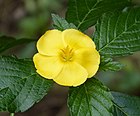Note: This is a project under development. The articles on this wiki are just being initiated and broadly incomplete. You can Help creating new pages.
Turnera ulmifolia
Turnera ulmifolia is an erect perennial plant with stems that can become woody. It usually grows up to 75cm tall. The plant is gathered from the wild for local used as a tea and medicine. It is sometimes cultivated for its medicinal uses.
Contents
- 1 Uses
- 2 Parts Used
- 3 Chemical Composition
- 4 Common names
- 5 Properties
- 6 Habit
- 7 Identification
- 8 List of Ayurvedic medicine in which the herb is used
- 9 Where to get the saplings
- 10 Mode of Propagation
- 11 How to plant/cultivate
- 12 Commonly seen growing in areas
- 13 Photo Gallery
- 14 References
- 15 External Links
Uses
Hair loss, Indigestion, Gastric problem, Desentery[1]
Parts Used
Chemical Composition
It contains two mixtures of steroids, sitosterol and stigmasterol (nonglycosylated and glycosylated); a mixture of flavonoids etc.[2]
Common names
| Language | Common name |
|---|---|
| Kannada | Mena mallige |
| Hindi | |
| Malayalam | |
| Tamil | |
| Telugu | |
| Marathi | |
| Gujarathi | |
| Punjabi | |
| Kashmiri | |
| Sanskrit | |
| English | West indian sage |
Properties
Reference: Dravya - Substance, Rasa - Taste, Guna - Qualities, Veerya - Potency, Vipaka - Post-digesion effect, Karma - Pharmacological activity, Prabhava - Therepeutics.
Dravya
Rasa
Guna
Veerya
Vipaka
Karma
Prabhava
Habit
Identification
Leaf
| Kind | Shape | Feature |
|---|---|---|
Flower
| Type | Size | Color and composition | Stamen | More information |
|---|---|---|---|---|
| Flowering from June to December |
Fruit
| Type | Size | Mass | Appearance | Seeds | More information |
|---|---|---|---|---|---|
| Fruiting from June to December |
Other features
List of Ayurvedic medicine in which the herb is used
Where to get the saplings
Mode of Propagation
How to plant/cultivate
The plant is widely cultivated as an ornamental in the tropics, where it often escapes from cultivation. It is reported to be invasive in several Pacific Islands.[4]
Commonly seen growing in areas
Hillsides, Savannahs, Often on open banks, Waste ground, Limestone.
Photo Gallery
References
- ↑ Indian Medicinal Plants by C.P.Khare
- ↑ Chemical constituents
- ↑ [Morphology]
- ↑ Cultivation
External Links
- Ayurvedic Herbs known to be helpful to treat Hair loss
- Ayurvedic Herbs known to be helpful to treat Indigestion
- Ayurvedic Herbs known to be helpful to treat Gastric problem
- Ayurvedic Herbs known to be helpful to treat Desentery
- Herbs with Leaf used in medicine
- Herbs with Root used in medicine
- Herbs with common name in Kannada
- Herbs with common name in English
- Habit - Perennial
- Index of Plants which can be propagated by Seeds
- Index of Plants which can be propagated by Cuttings
- Index of Plants which can be propagated by Division
- Herbs that are commonly seen in the region of Hillsides
- Herbs that are commonly seen in the region of Savannahs
- Herbs that are commonly seen in the region of Often on open banks
- Herbs that are commonly seen in the region of Waste ground
- Herbs that are commonly seen in the region of Limestone
- Herbs







